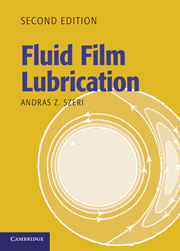Book contents
- Frontmatter
- Contents
- Preface to the Second Edition
- Preface to the First Edition
- Chapter 1 Introduction
- CHAPTER 2 Basic Equations
- CHAPTER 3 Thick-Film Lubrication
- CHAPTER 4 Dynamic Properties of Lubricant Films
- CHAPTER 5 Effects of Fluid Inertia
- CHAPTER 6 Flow Stability and Transition
- CHAPTER 7 Turbulence
- CHAPTER 8 Elastohydrodynamic Lubrication
- CHAPTER 9 Thermal Effects
- CHAPTER 10 Lubrication with Non-Newtonian Fluids
- CHAPTER 11 Gas Lubrication
- CHAPTER 12 Molecularly Thin Films
- CHAPTER 13 Biotribology
- Index
- References
CHAPTER 2 - Basic Equations
Published online by Cambridge University Press: 05 June 2012
- Frontmatter
- Contents
- Preface to the Second Edition
- Preface to the First Edition
- Chapter 1 Introduction
- CHAPTER 2 Basic Equations
- CHAPTER 3 Thick-Film Lubrication
- CHAPTER 4 Dynamic Properties of Lubricant Films
- CHAPTER 5 Effects of Fluid Inertia
- CHAPTER 6 Flow Stability and Transition
- CHAPTER 7 Turbulence
- CHAPTER 8 Elastohydrodynamic Lubrication
- CHAPTER 9 Thermal Effects
- CHAPTER 10 Lubrication with Non-Newtonian Fluids
- CHAPTER 11 Gas Lubrication
- CHAPTER 12 Molecularly Thin Films
- CHAPTER 13 Biotribology
- Index
- References
Summary
Fluid Mechanics
The equations employed to describe the flow of lubricants in bearings result from simplifications of the governing equations of fluid mechanics. It is appropriate, therefore, to devote a chapter to summarizing pertinent results from that subject. This summary will not be limited to concepts necessary to appreciate the classical theory of lubrication. A more than elementary discussion of fluid behavior is called for here, as various nonlinear effects will be studied in later chapters.
Our discussion begins with the mathematical description of motion, followed by the definition of stress. We will then derive Cauchy's equations of motion by substituting the rate of change of linear momentum of a fluid body and the forces acting on it into Newton's second law. This will yield three equations, one in each of the three coordinate directions. For an incompressible fluid these three equations will contain twelve unknowns: three velocity components (u, v, w) and nine stress components (Txx, Txy, …, Tzz). For compressible fluids there is an additional unknown, the density; for incompressible fluids the density is known a priori. To render the problem well posed, i.e., to have the number of equations agree with the number of unknowns so that a unique solution might exist, we will need to find additional equations. A fourth equation is easy to come by, by way of the principle of conservation of mass. The situation further improves on recognizing that only six of the nine stress components are independent, due to symmetry of the stress tensor. However, on specifying incompressibility of the fluid, a tenth unknown, the fluid pressure makes its debut. In contrast, for a compressible fluid both the pressure and the density are variables, but as they are connected through the equation of state, we count them as representing a single unknown. In summary, for both compressible and incompressible fluid we end up having four equations and ten unknowns. Six additional equations are required.
- Type
- Chapter
- Information
- Fluid Film Lubrication , pp. 54 - 87Publisher: Cambridge University PressPrint publication year: 2010



